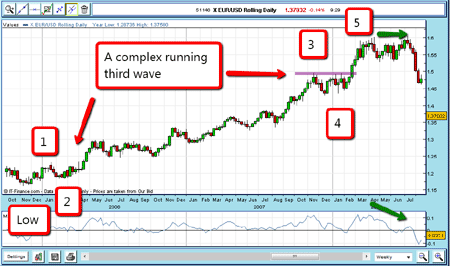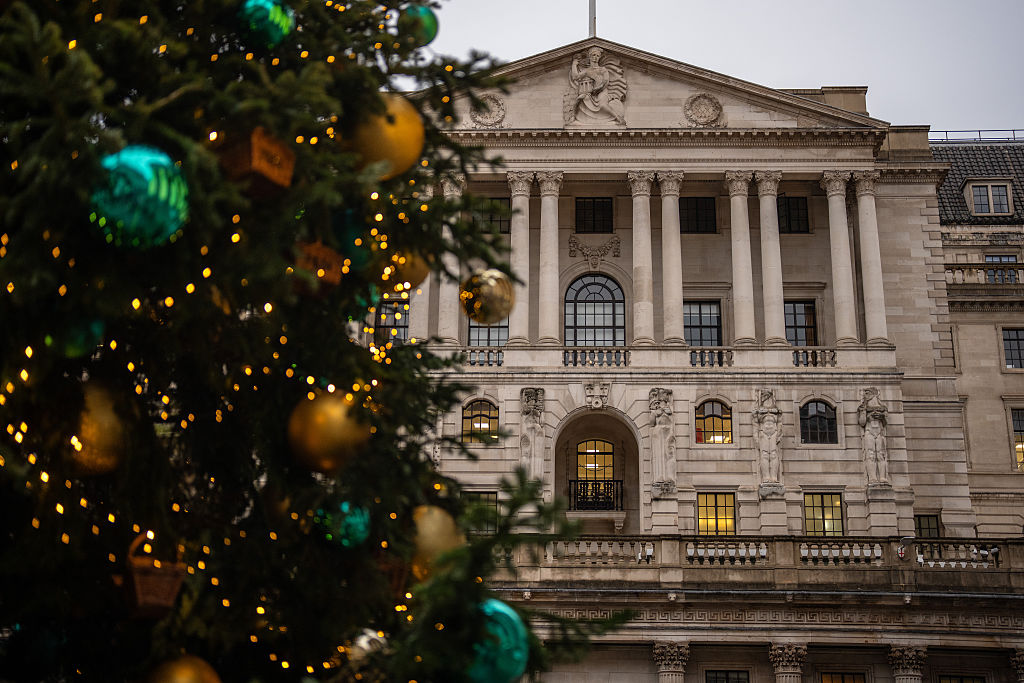How to spot Elliott waves
Elliott wave theory can be a very practical market forecasting tool. But its application is as much an art as a science. John C Burford explains how to use Elliot waves when spread betting.
When I first started trading, I was aware of Elliott wave theory. But at the time, the rules and guidelines had not been developed very fully, and I found it exceedingly difficult to use in real market conditions.
Maybe it was just me. But needless to say, I lost interest in using it in my trading. It seemed so arbitrary. I'm sure many budding spread-betters feel the same way as I did.
However, over the years, I found that several very smart people had codified the theory into a very practical forecasting tool. I use it extensively now and I still have a lot to learn.
MoneyWeek
Subscribe to MoneyWeek today and get your first six magazine issues absolutely FREE

Sign up to Money Morning
Don't miss the latest investment and personal finances news, market analysis, plus money-saving tips with our free twice-daily newsletter
Don't miss the latest investment and personal finances news, market analysis, plus money-saving tips with our free twice-daily newsletter
Why am I telling you this? Well, because since starting my column here, I've had several queries from spread betters wanting to know more about how to use Elliott waves in their trading.
It's an important subject. So I'll be aiming to cover many of its facets over the course of the next few weeks. Hopefully, you may pick up some useful tips that could improve your performance.
A reminder of Elliott basics
Let me recap on the basic idea. Elliott discovered, after poring over many price charts (especially of the Dow Jones Industrials), that price moves occur in waves. Great sweeps up and down appear in all time-frames, from weekly to minute-by-minute scales.
He noted that the big bull and bear markets occur in five main waves, while the counter-trend corrections to the main trend occur in three main waves. After the fifth wave, the trend changes. That was his major discovery, and all Elliott wave practitioners use this concept as the basis of their forecasting.
If we can identify the end of the fifth wave of a five-wave sequence, we can say that the trend is about to change (at least, with a high degree of probability).
But herein lies the problem: how do we know the fifth wave has ended? And how do we know that our wave count labels are correct?
Applying Elliot wave theory is as much art as science
Learning how to use the Elliott wave theory is as much an art as a science. I liken it to learning to play a musical instrument. To play it well takes lots of practice, and a certain talent. Music is all about patterns in sound, while trading is all about patterns in price. These price patterns are clearly displayed on our screens.
To help us identify the correct wave labels, we have other tools at our disposal. I feel that combining Elliott Wave ideas with other unrelated indicators can give us excellent high-probability entry and exit points.
Of course, you can't expect certainty here. As the markets progress in real time, you have to use working assumptions based on what the market has given you up to that point. But you can improve your odds greatly by using other technical evidence. I'll demonstrate this by taking an example drawn from the EUR/USD, which conforms beautifully to Elliott wave theory and to the Fibonacci principles.
The long-term EUR/USD bull market 2006-2007
The weekly chart below shows the big bull market in EUR/USD, taking the rate from $1.16 to $1.60 a considerable move of 38%. The November 2005 low at $1.16 was made after a bear move. This gives us the low pivot to kick off our Elliott Wave count as our working assumption.
Of course, if the market then made a new low, we would have to abandon this count. Those are the breaks!

(Click on the chart for a larger version)
So, when starting off a count, we have to admit that we may have to change our ideas, if the market does not co-operate. One of the beauties of the Elliott wave theory is that the market will tell you pretty quickly if you have got your count wrong. This fact allows you to limit your losses.
Let's go with our idea that the November 2005 low is the real low. In January, the market moved up. Now this could have been a simple corrective move in a bear market, leading to a new low. But note that the momentum reading was very oversold. This is a clue that the bounce off the $1.16 level should be bigger than just a minor bear market rally.
So even if the market again turned down to a new low, the rally should be big enough to give us at least some profit. If that happened, we would keep looking for the low and start again.
One possible trading strategy would be to place buy orders just above the January $1.23 high. Why? Well, this is where knowing a little trader psychology can come in very useful. There were bound to be lots of buy stops there (points at which investors who were shorting the market would cut their losses or take their profits), because bearish traders would want to protect their profits from riding the 2005 bear move. I find these important chart points coming near the end of a big run are very significant.
After breaching that high, the market could not look back and gave a big trend upwards. Your usual trading-with-the-trend methods could then be employed.
Labelling the big moves
Now we can apply tentative Elliott wave labels. The January high is wave 1, the February dip was wave 2, and the big uptrend was a probable wave 3. Third waves are magnificent. Here are some of their characteristics:
They are never the shortest wave, and they are often the longest
They exhibit 'impulsive' behaviour
They can themselves often be broken down into a smaller-scale five-wave pattern
Corrections are mostly minor and short-lived, compared with the wave duration
Look at the big rally up until November 2007 (I've reprinted the chart from above for convenience).

(Click on the chart for a larger version)
The push from August was made on increasing momentum. But still no sign of a top until the triangle formation from November until February. When the market made a thrust upwards in February into new high ground, we can put the labels 3 and 4 in. We know that when we have a triangle in wave 4, then the market will thrust up into the final wave, wave 5.
Very often, the fifth wave spikes up and then reverses just as quickly. That is one of the features of fifth waves after a triangle. And that is what we got the market topped out in April and began a complex topping process before reversing down. Momentum was already weakening in the top another clue that the top was in.
The Elliott wave theory, when applied properly, gives you a firm idea of what to expect up ahead. If the market cooperates, you have your labels correct. If it does not, then you do not have the correct labels, and you will have to go back to the drawing board. I do it often.
When researching a market, I like to start off with the weekly chart to give me a feel of the long-term trend, if any. Then I go to my dailies, and if promising, to the hourly. I don't need to go any shorter than this, but if you are a day-trader, using the five-minute charts are also very useful.
One further important point on any chart, there is at least one other possible alternative interpretation! This is where it can get confusing, and I hope to get onto this in a future post. I will say that it all looks obvious post facto, but in real time, it's anything but.
NB: Don't miss my next bit of trading advice. To receive all my spread betting blog posts by email, as soon as I've written them, just sign up here .
Get the latest financial news, insights and expert analysis from our award-winning MoneyWeek team, to help you understand what really matters when it comes to your finances.
John is is a British-born lapsed PhD physicist, who previously worked for Nasa on the Mars exploration team. He is a former commodity trading advisor with the US Commodities Futures Trading Commission, and worked in a boutique futures house in California in the 1980s.
He was a partner in one of the first futures newsletter advisory services, based in Washington DC, specialising in pork bellies and currencies. John is primarily a chart-reading trader, having cut his trading teeth in the days before PCs.
As well as his work in the financial world, he has launched, run and sold several 'real' businesses producing 'real' products.
-
 £100 contactless card limit to be lifted
£100 contactless card limit to be liftedConsumers will be able to set their own contactless limits from March 2026, under new rules from the Financial Conduct Authority
-
 MoneyWeek news quiz: How much did the Bank of England cut interest rates by?
MoneyWeek news quiz: How much did the Bank of England cut interest rates by?Quiz Interest rates, inflation, unemployment, and bank closures all made headlines this week. How closely were you following the news?